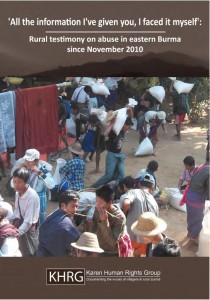All the information I’ve given you, I faced it myself: Rural testimony on abuse in eastern Burma since November 2010
By Karen Human Rights Group • December 15, 2011 Human rights abuses faced by ethnic communities across rural eastern Burma have continued since November 2010, and are consistent with patterns KHRG has documented since 1992. Drawing from a dataset of 1,270 oral testimonies, sets of images and documentation written and collected over the last year by villagers trained to monitor human rights conditions in their own communities, this report presents information on 17 categories of abuse and quantifies their occurrence across KHRG research areas. By placing recent testimony from villagers in the context of twenty years of abusive practices, this report should make clear that developments since the 2010 elections have neither expanded villagers’ options for claiming their human rights, nor addressed the root causes of abuse in rural eastern Burma. External assessments of developments in Burma that ignore local perspectives on continuing human rights abuse thus exclude the input of the most knowledgeable and engaged stakeholders – who also stand to lose the most from inaccurate conclusions drawn without their participation. The testimony presented in the report should thus function as a critique of any attempt to assess changes in Burma that ignores local perspectives, and a call to heed the concerns of rural people who are gauging, on a day-to-day basis, the way past, present and continuing abuse impacts the future for communities in eastern Burma.
Human rights abuses faced by ethnic communities across rural eastern Burma have continued since November 2010, and are consistent with patterns KHRG has documented since 1992. Drawing from a dataset of 1,270 oral testimonies, sets of images and documentation written and collected over the last year by villagers trained to monitor human rights conditions in their own communities, this report presents information on 17 categories of abuse and quantifies their occurrence across KHRG research areas. By placing recent testimony from villagers in the context of twenty years of abusive practices, this report should make clear that developments since the 2010 elections have neither expanded villagers’ options for claiming their human rights, nor addressed the root causes of abuse in rural eastern Burma. External assessments of developments in Burma that ignore local perspectives on continuing human rights abuse thus exclude the input of the most knowledgeable and engaged stakeholders – who also stand to lose the most from inaccurate conclusions drawn without their participation. The testimony presented in the report should thus function as a critique of any attempt to assess changes in Burma that ignores local perspectives, and a call to heed the concerns of rural people who are gauging, on a day-to-day basis, the way past, present and continuing abuse impacts the future for communities in eastern Burma.
Download the report, appendix I, II and III
Tags: Burma Army, Human Rights, Karen Human Rights Group, Karen StateThis post is in: Crimes Against Humanity, Military Regime
Related Posts21st Century Panglong Conference Reaffirms Obstacles to Peace
Torture, extrajudicial killing, and use of civilians as human shields by Burma Army during new offensive against SSPP/SSA near Upper Yeywa dam site in Kyaukme
Time for a Fresh Start for Genuine Peace
An Open Letter to World Leaders on the Fourth Anniversary of The Resumption of War Calling Urgently for Humanitarian Aid for The Internally Displaced People of Northern Burma
The Burma Government Must Stop Condoning Sexual Violence in Conflict Areas









 All posts
All posts